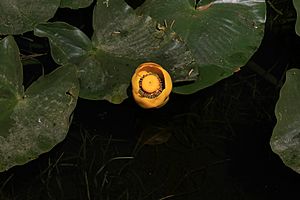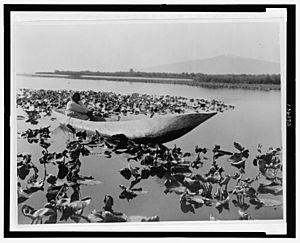Nuphar polysepala facts for kids
Quick facts for kids Nuphar polysepala |
|
|---|---|
 |
|
| Leaves and flower. Yellowstone National Park. | |
| Scientific classification | |
| Genus: |
Nuphar
|
| Species: |
polysepala
|
The great yellow pond-lily, also known as wokas, is a beautiful water plant found in western North America. Its scientific name is Nuphar polysepala. The word "Nuphar" comes from Greek and means "water-lily." "Polysepala" means "many sepals," which are like small leaves that protect the flower bud. You can easily spot this plant in shallow, muddy ponds from Alaska all the way down to New Mexico. It stands out with its big floating leaves and bright yellow flowers.
Contents
Where the Great Yellow Pond-Lily Lives
This water plant loves shallow, muddy ponds. You can find it growing in many places across western North America. Its range stretches from northern Alaska and Yukon in the north. It goes all the way south to central California and northern New Mexico.
How the Pond-Lily Grows and Reproduces
The great yellow pond-lily can grow in two ways. It can grow from seeds, or it can grow from special underground stems called rhizomes.
Seeds and Rhizomes
Seeds are usually collected from mid-August to early October. These seeds can then grow into new plants.
Rhizomes are thick, fleshy stems that grow underground in the mud. They are like hidden roots that help the plant spread. It can be tough to dig them out because they are deep in the mud.
Floating Leaves
The leaves of the great yellow pond-lily float on the water's surface. They have a waxy coating that keeps them dry. This coating helps the leaves breathe easily. The leaves are shiny green and shaped like an oval. They can be quite large, from 10 to 45 centimeters long. They also have a notch where the leaf stem connects. These big leaves offer a safe hiding spot for fish.
Flowers and Fruit of the Pond-Lily
The flowers of the great yellow pond-lily are bright yellow. They are usually 5 to 10 centimeters wide. Each flower has 6 to 12 sepals, which look like petals. Most often, there are 9 sepals. The true petals are very small and are hidden inside the flower. They are found close to the stamens, which are the parts that hold pollen. If you look inside the flower from above, you can see the red anthers.
What Happens After the Flower Blooms?
After the flower blooms, it develops into a fruit. This fruit is a green to yellowish capsule. It is shaped like an oval. The fruit is usually 4 to 6 centimeters long and 3.5 to 6 centimeters wide. Sometimes, it can grow up to 9 centimeters long.
Uses of the Great Yellow Pond-Lily
This plant has been useful to people for a long time. Different parts of the plant can be used for food and even for medicine.
Food from the Pond-Lily

The seeds of the great yellow pond-lily are edible. This means you can eat them! They can be cooked in different ways. Some people pop them like popcorn. You can also steam them like a vegetable. Another way is to dry them and grind them into flour. They can even be cooked like oatmeal.
The seeds were a very important food source for the Klamath and Modoc tribes. These Native American groups lived near Oregon's Upper Klamath Lake. The seeds gave them a lot of energy.
Medicinal Uses
Parts of the great yellow pond-lily have also been used in traditional medicine. The leaves and rootstocks (rhizomes) were used to treat skin problems. They helped with conditions like ulcers and swelling.
A special liquid made from the rootstock was also used. This liquid, called an infusion, was a traditional gargle. People used it to help with sore mouths and throats. To make it, two tablespoons of chopped rhizome were mixed with one cup of boiling water.

